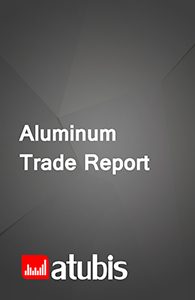Turkey’s Aluminum Casting Parts Market Outlook Report
9,718€
- TRY: 475,000 ₺
Aluminum casting parts are part of the downstream supply chain of the aluminum industry; raw materials for the sector include both primary and secondary sources. One of the unique properties of aluminum in addition to the high specific strength and its high electrical and thermal conductivity, is the relatively low melting point that makes casting possible at low costs. Aluminum casting parts are produced using a variety of processes. Among these, pressure die casting and permanent mold casting are the most common. Sand casting also takes a considerable share of the market owing to low initial cost requirements.
Product Description
The possibility of casting aluminum into complex shapes has translated into wide applications of casting parts in various industries. But the automotive industry and home appliances, in that order, are two major consumers of aluminum casting parts. The construction sector (faucets and other components) followed by electric and electronic products (as connectors) are also large consumers of aluminum casting parts.
With a GDP of $761 billion in 2019, Turkey was the second largest economy in the region that year, behind Saudi Arabia. The country joined the Economic Cooperation Organization in 1961 and also became a member of G20 in 1991. However, Turkey is still a developing country, according to the UN in 2019. With an annual consumption of 1.2 million tonnes of aluminum, the country is the largest consumer in the region. But there is only one primary smelter in the country, which has ramped up capacity to 82,000 tonnes since late 2015 with renovation and improvement plans. High power costs (a major part of aluminum production costs) have made primary aluminum production less attractive in Turkey.
Market drivers of Turkey’s aluminum casting parts
The auto sector is the major consumer of aluminum casting parts; thanks to developments in the sector over the recent years, Turkey’s domestic demand has grown significantly. Turkey is now home to the largest auto industry in the region, having taken the crown from Iran. A significant share of the cars and auto parts produced in Turkey is exported to Europe; given the price advantage of Turkish products compared to their European rivals, the outlook for the market seems positive.
Turkey reported the first case of Covid-19 in the latter half of March 2020. Not much longer, in mid-April, daily confirmed cases exceeded 5,000 and the country was officially facing a pandemic. To fight the pandemic, the government restricted businesses and ordered nation-wide lockdowns. As a result, the country’s mobility index dropped to around 60%. Thus, Turkey’s real GDP growth is forecast to be around -1%. With the restrictions implemented by the government due to the Covid-19 pandemic, demand for aluminum casting parts will fall. Moreover, the spread of Covid-19 in Turkey’s export destinations will weigh on the country’s exports.
Overview of Turkey’s aluminum casting parts market
The consumption of aluminum casting parts depends heavily on the automotive market. The country’s auto sector has developed significantly over the years; it has now surpassed Iran to take the first place in the region. Moreover, the country’s auto industry, unlike Iran’s, which has focused on the domestic market, exports a large share of its output. Over the past two decades, Turkey’s auto sector has grown 6.6% on average per year and total output of passenger vehicles is currently about 1.46 million units. Since auto manufacturing is expected to grow over the coming years (albeit at a slower pace), demand for aluminum casting parts is forecast to grow.
Breakdown of Turkey’s aluminum casting parts market
Domestic demand for aluminum casting parts in the forecast timeframe as well as the previous period has been broken down using three factors. The first factor breaks down the market into three categories based on alloy material: commercially pure aluminum, heat-treatable alloys, and non-heat-treatable alloys. Past and future trends for each type of material have been analyzed. Heat-treatable alloys hold the largest share of the market. In the second breakdown, products are distinguished based on production processes: die casting, permanent mold casting, sand casting, and other casting methods, with die casting and permanent mold casting taking the largest share in the market. Finally, using the third factor, aluminum casting parts are categorized based on their applications in different industries. The transportation industry sector is the largest consumer of aluminum casting parts in Turkey.
Key players in Turkey’s aluminum casting parts market:
- SPALTEK Aluminum Foundry
- Natamak Otomotiv San.
- Deniz Metal Casting
- Er Döküm Makina Sanayi Ve Ticaret A.Ş.
- Kokil Metal
- Şirvanlı Alüminyum Döküm
- Süperpar Otomotiv A.S.
Additional Information
| Industry | Aluminium Casts |
|---|---|
| Region | Turkey |
| Report Type | Industry Report |
Specifications
| Report Attribute | Details |
| The base year for estimation | 2019 |
| Historical data | 2009-2018 |
| Forecast period | 2020-2025 |
| Quantitative units | Value in USD and Volume in Tonne |
| Report coverage | Market Overview, Dynamics, Market Outlook, Risks to Forecast, Consumer Market, Industry Overview, Market Landscape, Competitive Landscape, Market Attractiveness, External Macro Environment Analysis |
| Segments covered | Composition, Type, Application |
| Pricing and purchase options | Please explore our purchase options to meet your exact research needs. |
Reasons to Buy
- Recognize the geographical distribution of import demand
- Identify the current and future key players of the trading market
- Achieve a better insight on potential target markets
- Understand the behavior of major suppliers/customers either globally or regionally
- Identify competitors as a feed for market analysis
Table of Contents
- Executive summary
- Introduction
- Objective
- Market under study
- Product
- Product specifications
- Consumption structure
- Applications
- Physical properties
- Subjects discussed
- Geographical scope under study
- Study timeframe
- Study currency
- Potential audience
- Market dynamics
- Market drivers
- Restraints
- Opportunities
- Challenges
- Market overview
- Market size
- Industry capacities
- Existing capacities
- Capacity distribution
- Geographical distribution of capacities
- Future capacities
- Existing capacities
- Output
- Output trends
- Operating rates
- Consumption
- Consumption trend
- Consumption Share of domestic product
- Trade
- Exports
- Imports
- Trade balance
- Market balance
- Market breakdown by product type
- Market breakdown by product type
- Market breakdown by application
- Inventory
- Producers inventory
- Consumers inventory
- Traders inventory
- Market outlook
- Market factors
- Raw materials
- Costs and prices
- Competition
- The government
- Other factors
- Future scenarios
- Risks to forecast
- Market factors
- Consumer markets
- End-user markets
- Building construction
- Infrastructure construction
- Transportation manufacturing
- Industrial equipment manufacturing
- Durable goods manufacturing
- Consumable goods manufacturing
- Direct consumer markets
- Major Direct consumers
- Existing capacities
- Drivers
- Major Direct consumers
- End-user markets
- Export potentials
- Destinations
- Trade and insurance costs
- Import market suppliers
- Producers potential share
- Destinations
- Industry overview
- Raw materials
- The supply volume of raw materials
- Supply channels of raw materials
- Raw materials procurement costs
- Cost structure of producers
- Production cost curve
- Industry value added
- Generated new scrap
- Technology
- Raw materials
- Market landscape
- Domestic sales markets
- Pricing in the domestic market
- Potential domestic demand
- Trade agreements for imports
- Foreign suppliers
- Foreign sales market
- Prices
- Potential markets overview
- Trade agreements for exports
- Foreign customers
- Domestic sales markets
- Competitive landscape
- Producers
- Company profile
- Revenue structure
- Gross profit margins
- Capacity, output and sales
- Consumers
- Company profile
- Revenue structure
- Gross profit margins
- Capacity, output and sales
- Producers
- Market attractiveness
- Industry rivalry
- Threat of new entrants
- Threat of substitutes
- Bargaining power of buyers
- Bargaining power of suppliers
- Conclusion of Porter analysis
- PESTEL analysis
- Political factors
- Economic factors
- Social factors
- Technology factors
- Environmental factors
- Legal factors
- SWOT analysis
- Large-scale companies with favorable conditions
- Short-term strategies
- Long-term strategies
- Large-scale companies with unfavorable conditions
- Short-term strategies
- Long-term strategies
- Small enterprises with favorable conditions
- Short-term strategies
- Long-term strategies
- Small enterprises with unfavorable conditions
- Short-term strategies
- Long-term strategies
- Large-scale companies with favorable conditions
List of Figures
- Output and consumption; 2010-2019
- Market share of product applications; 2019
- Market surplus; 2019-2025
- Production process flowchart
- Market size; 2010-2025
- Existing capacity; 2010-2019
- Capacity distribution; 2019
- Geographic distribution of capacities; 2019
- Development of future capacity; 2010-2025
- Amount of output; 2010-2025
- Operating rates of production plants; 2010-2025
- Amount of consumption; 2010-2025
- Consumption share of domestic product; 2010-2025
- Exports of product; 2010-2019
- Imports of product; 2010-2019
- Historical trade balance; 2010-2019
- Future Market balance; 2021-2025
- Market output breakdown by alloy type; 2010-2025
- Market consumption breakdown by alloy type; 2010-2025
- Market balance breakdown by alloy type; 2010-2025
- Market output breakdown by product type; 2010-2025
- Market consumption breakdown by product type; 2010-2025
- Market balance breakdown by product type; 2010-2025
- Market consumption breakdown by application; 2010-2025
- Inventories of raw materials and products at producers factories; 2010-2019
- Consumers’ inventory of product; 2010-2019
- Traders’ inventory; 2010-2019
- Production forecast, according to raw materials and sales analysis; 2019-2025
- Market surplus; 2019-2025
- The share of end-user industries in the consumption; 2010 and 2019
- Changes in the end-consumption of extrusion products; 2019 vs 2025
- Applications in building construction industry; 2019
- Applications in infrastructure construction industry; 2019
- Applications in transportation manufacturing industry; 2019
- Applications in industrial equipment manufacturing industry; 2019
- Applications in durable goods manufacturing industry; 2019
- Applications in consumable goods manufacturing industry; 2019
- Capacity distribution structure of direct consumers; 2019
- Existing capacities of direct consumers in each province; 2019
- Suppliers of the export potential destination; 2019
- Historical exports to the export potential destination and future potential; 2016-2025
- Up-stream domestic supply; 2010-2019
- Raw materials domestic supply; 2010-2019
- Supply channels of producer plants
- Spot price of raw material in the market; 2010-2025
- Cash cost structure for production the product; 2019
- Production cost curve of the plants; 2019
- Gross value added of the industry; 2010-2019
- Generated new scrap; 2010-2019
- Sales channels
- Realized price of the product in the market; 2010-2025
- Potential demand of each province; 2019
- The main foreign suppliers to the market; 2010-2019
- FOB price vs domestic market; 2010-2025
- Map of global major importers > 20,000t; 2019
- Major foreign customers; 2010-2019
- Revenue structure of the producers; FY2019
- Sales income and gross profit margin of the producers; FY2010-2019
- Output and sales of the producers; FY2010-2019
- Revenue structure of the consumers; FY2019
- Sales income and gross profit margin of the consumers; FY2010-2019
- Output and sales of the consumers; FY2010-2019
- SWOT matrix for large-scale companies with favorable conditions
- Strategies positioning for large-scale companies with favorable conditions
- SWOT matrix for large-scale companies with unfavorable conditions
- Strategies positioning for large-scale companies with unfavorable conditions
- SWOT matrix for small enterprises with favorable conditions
- Strategies positioning for small enterprises with favorable conditions
- SWOT matrix for small enterprises with unfavorable conditions
- Strategies positioning for small enterprises with unfavorable conditions
You may also like…
-

Bahrain Aluminum and Semis Market Overview
102€
- TRY: 5,000 ₺
-

The Trend of Aluminum Smelters’ Profitability
102€
- TRY: 5,000 ₺
-

-



